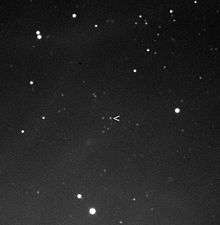Elara (moon)
Elara /ˈɛlərə/ is a prograde irregular satellite of Jupiter. It was discovered by Charles Dillon Perrine at Lick Observatory in 1905.[1][2] It is the eighth-largest moon of Jupiter and is named after Elara, one of Zeus's lovers and the mother of the giant Tityos.[7]
 Elara near the glare of bright Jupiter | |
| Discovery | |
|---|---|
| Discovered by | C. D. Perrine |
| Discovery date | January 5, 1905[1][2] |
| Designations | |
Designation | Jupiter VII |
| Pronunciation | /ˈɛlərə/[3] |
Named after | Ελάρα Elăra[4] |
| Adjectives | Elarian /ɛˈlɛəriən/ |
| Orbital characteristics [5] | |
| 11741000 km | |
| Eccentricity | 0.217 |
| +259.6 days | |
| 333.0° | |
| Inclination | 26.63° |
| 109.4° | |
| 143.6° | |
| Satellite of | Jupiter |
| Group | Himalia group |
| Physical characteristics | |
Mean diameter | 78 km |
| Mass | 8.7×1017 kg |
Mean density | 2.6 g/cm3 (assumed)[6] |
| ~0.031 m/s2 (0.003 g) | |
| ~0.052 km/s | |
Sidereal rotation period | ~0.5 d (12 h) |
| Albedo | 0.04 (assumed)[6] |
| Temperature | ~124 K |
| 16.6 | |
Elara did not receive its present name until 1975; before then, it was simply known as Jupiter VII. It was sometimes called "Hera"[8] between 1955 and 1975. It has a mean radius of just 43 kilometres (27 mi), thus it is 2% of the size of Europa. However, it is half the size of Himalia, so it is the second-biggest moon in the Himalia group. It might be a captured type C or D asteroid, for it reflects very little light.
Elara belongs to the Himalia group, five moons orbiting between 11 and 13 gigametres from Jupiter at an inclination of about 27.5°.[9] Its orbital elements are as of January 2000. They are continuously changing due to solar and planetary perturbations.
New Horizons encounter
In February and March 2007, the New Horizons spacecraft to Pluto captured Elara in several LORRI images from a distance of five million miles.[10]
See also
References
- Perrine, C. D. (February 27, 1905). "Satellites of Jupiter". Harvard College Observatory Bulletin. 178.
- Perrine, C. D. (1905). "The Seventh Satellite of Jupiter". Publications of the Astronomical Society of the Pacific. 17 (101): 62–63. Bibcode:1905PASP...17...56.. doi:10.1086/121624. JSTOR 40691209.
- James Knowles (1851) A Critical Pronouncing Dictionary of the English Language
- DGE en línea
- S.S. Sheppard (2019), Moons of Jupiter, Carnegie Science, on line
- "Planetary Satellite Physical Parameters". JPL (Solar System Dynamics). Retrieved August 10, 2009.
- Marsden, Brian G. (October 7, 1975). "Satellites of Jupiter". International Astronomical Union. Archived from the original on February 22, 2014.
- Payne-Gaposchkin, Cecilia; Katherine Haramundanis (1970). Introduction to Astronomy. Englewood Cliffs, N.J.: Prentice-Hall. ISBN 0-13-478107-4.
- Jacobson, R. A. (2000). "The orbits of outer Jovian satellites" (PDF). Astronomical Journal. 120 (5): 2679–2686. Bibcode:2000AJ....120.2679J. doi:10.1086/316817.
- Hamilton, Thomas Wm. (2013). Moons of the solar system. Strategic Book Publishing. p. 21. ISBN 1625161751.
External links
- Elara on 1998-08-15 03:21 UTC(Crédit: OHP/IMCCE/CNRS)
- SkyView 23 47 09 -02 40 46
- HORIZONS Web-Interface, JPL
- Elara: Overview by NASA's Solar System Exploration
- David Jewitt pages
- Jupiter's Known Satellites (by Scott S. Sheppard)
- "Two Irregular Satellites of Jupiter" (Himalia & Elara: Remanzacco Observatory: November 23, 2012)